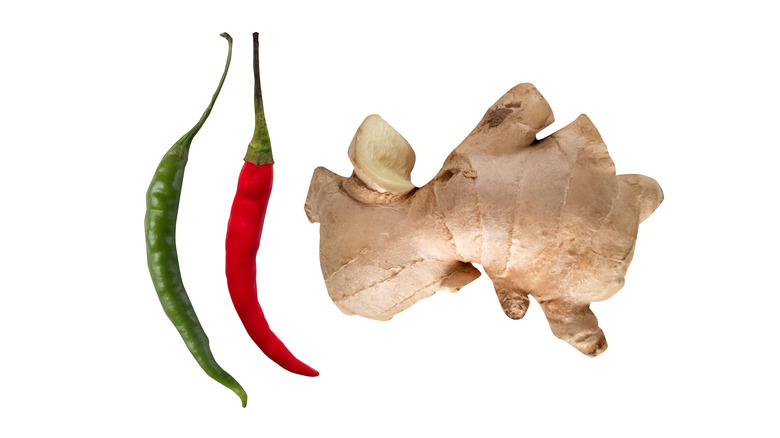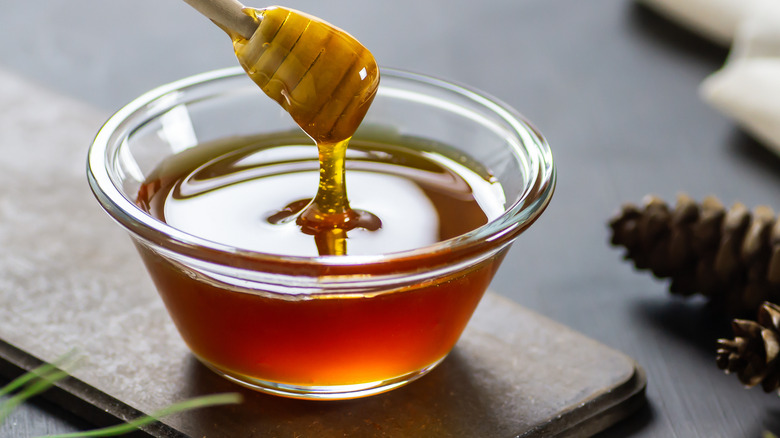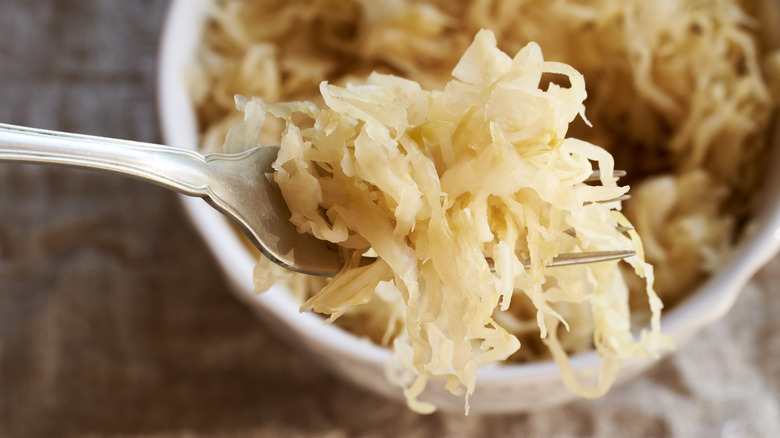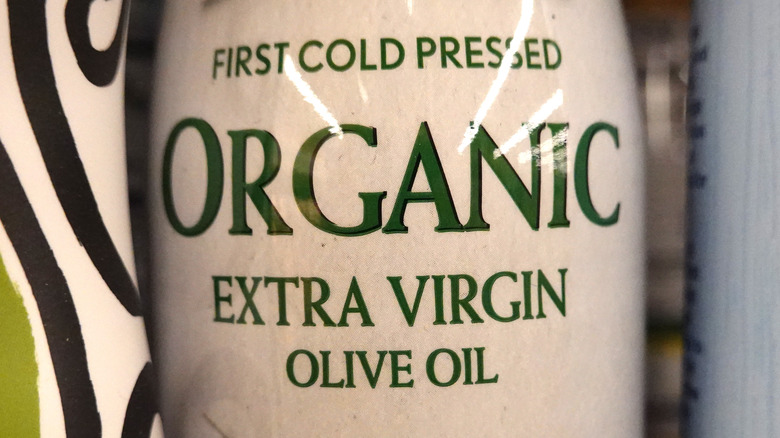Changes To Your Diet Can Affect Your Allergies - Here's How
Allergic reactions are a very common occurrence in the United States, affecting more than 50 million people annually (per Cleveland Clinic). People with airborne (inhalant) allergies often suffer from stuffy nose, runny nose, sneezing, and itchy/watery eyes. Among seasonal allergies, tree pollens trigger allergies in the spring, while weed pollens appear in the fall. Perennial (year-round) allergies include dust mites, cockroaches, molds, and pet allergens (e.g., fur, dander). Hives or itching shortly after eating may be a sign of an allergic reaction to a food. Severe reactions (anaphylaxis), marked by swelling of the mouth, throat, tongue, or face, can also occur in response to eating certain foods. Food allergies common in both children and adults include milk, egg, wheat, soy, peanut, and tree nuts.
In some people, certain medications and herbal supplements can also elicit an allergic reaction. For example, some antibiotics may cause rashes, itchiness, swelling, or breathing problems. Another source of allergic reactions (usually skin rash) is latex, found in rubber products such as balloons, rubber gloves, and condoms. Venom from stinging insects (bees, wasps, and hornets) can also cause allergic reactions. Symptoms can include shortness of breath, swelling in the throat, wheezing, rapid heartbeat, dizziness, and low blood pressure.
The increasing prevalence of allergies may be partly due to the "hygiene hypothesis," which states that children with limited exposure to germs develop an overreactive immune system that leads to allergies and allergic diseases later in life (via a 2021 review in Foods).
Causes and risk factors for allergies
When first exposed to a foreign protein (allergen), the immune system of an allergic person mistakenly identifies the allergen as an invader (per InformedHealth.org). As a result, specific antibodies (immunoglobulin E, or IgE) are created that bind to specialized cells called mast cells located in the skin, airways, and gastrointestinal tract. The immune system thus becomes sensitized to the allergen, though symptoms may not occur. Subsequent exposure to the allergen (after sensitization to the allergen) signals the mast cells to release a burst of histamine and other chemicals that initiate the development of symptoms such as hives, runny nose, and sneezing. The same offending allergen would go unnoticed and not cause any reaction in nonallergic people.
A person with a family history of allergies and related conditions (e.g., asthma) has a greater risk of developing an allergy. This genetic predisposition to develop allergies and allergic conditions is known as atopy. Various environmental factors, including air pollution and cigarette smoke, also contribute to the likelihood of developing an allergy.
While certain foods and beverages can improve allergies, others can make allergies worse. Read on to find out how changes to your diet can affect your allergies.
Apples, berries, and onions
Apples, berries, and onions are among the richest food sources of the potent flavonoid compound quercetin (via Life Extension). Other excellent sources include dark-colored grapes, kale, capers, buckwheat, and green tea. Quercetin's antioxidant and anti-inflammatory properties contribute to many health benefits, including supporting healthy immune function, blood pressure, and blood sugar, as well as the elimination of old, inflammatory senescent cells that accumulate with advancing age.
According to a 2016 review in Molecules, quercetin also has anti-allergy properties. Quercetin suppresses the production of and secretion of histamine from mast cells and basophils (another type of immune cell) sensitized by allergens. Histamine and other chemicals are responsible for common allergy symptoms such as itching, sneezing, and watery eyes. Quercetin also inhibits the release of inflammatory chemicals known as cytokines from mast cells, accounting for its therapeutic effect against allergic inflammatory diseases such as asthma. Moreover, animal studies have shown that over a quarter of absorbed quercetin concentrates in lung tissue.
As an anti-allergy agent, quercetin functions specifically as a mast cell stabilizer, a drug or natural compound that stabilizes the membranes of mast cells, preventing their activation and blocking the releases of histamine and other chemicals. In fact, quercetin is structurally similar to cromolyn, a medication used to prevent allergic reactions. Impressively, quercetin is more effective than cromolyn at suppressing the release of inflammatory cytokines from mast cells. With regard to food allergy, quercetin has been shown in animal models to significantly inhibit the IgE allergic response against peanut proteins.
Pineapple and papaya
The digestion of dietary protein is primarily carried out by proteolytic enzymes (or proteases) produced by the digestive system, notes Healthline. Pepsin begins breaking down protein foods (e.g., meat, eggs) in the stomach, while trypsin and chymotrypsin (produced by the pancreas) complete the process in the small intestine. Proteolytic enzymes are also found in certain foods, most notably fresh pineapple and fresh papaya. Papaya fruit contains papain, a protein-digesting enzyme commonly used as a meat tenderizer. Fresh pineapple served with pork helps to break down the meat because it contains bromelain, another potent proteolytic enzyme (via a 2014 study in the Korean Journal for Food Science of Animal Resources).
Bromelain and papain are associated with various health benefits, particularly improved digestion. Bromelain also has potent anti-inflammatory activity as well as mucolytic properties, i.e., it can break down mucus (via a 2021 review of studies published in the journal Life (Basel). Thus, by reducing nasal inflammation and mucus, bromelain may be useful in the treatment of allergic rhinitis and rhinosinusitis. In addition, bromelain can improve asthma symptoms by reducing airway inflammation. Pineapple has a long history of use as a traditional medicine in South and Central America. Papaya-derived papain has also been used in folk medicine for the treatment of various disorders including inflammation and allergies (per a 2021 study in the International Journal of Molecular Sciences).
Cayenne pepper and ginger
According to a 2019 study in the World Allergy Organization Journal, capsaicin is the main bioactive ingredient in cayenne pepper that is responsible for its spicy taste, as well as various health benefits. Antioxidant and anti-inflammatory properties associated with capsaicin may contribute to its potential benefits in the management of food allergy. In a mouse model of food allergy, supplementation with capsaicin was shown to decrease allergic inflammation and oxidative stress (free radical damage). This resulted in lower levels of interleukin 33 (IL-33), a proinflammatory cytokine that plays an important role in the development of allergic diseases. The study authors suggest that continuous consumption of capsaicin over a longer period may mitigate food allergy.
Another popular spice, ginger, can improve symptoms related to seasonal allergies (via a 2016 study in The Journal of Nutritional Biochemistry). Ginger has been used for centuries in Chinese and Indian medicine to treat nausea, asthma, and other disorders. Ginger also has antiallergy effects owing to its major bioactive component known as 6-gingerol. In mice with allergic rhinitis (hay fever), administration of ginger powder and 6-gingerol alleviated allergy symptoms such as sneezing and nasal rubbing. Specifically, 6-gingerol was demonstrated to inhibit the production of inflammatory cytokines, thus preventing the activation of mast cells that would otherwise release histamines that trigger symptoms of allergic rhinitis.
Cantaloupe and citrus fruit
One of the many benefits of eating more fruits and vegetables is shoring up your vitamin C levels. At the top of the list are cantaloupe and citrus fruits such as oranges, grapefruit, and limes (via WebMD). Broccoli, kiwi, red cabbage, and bell peppers are also high in vitamin C. While vitamin C has become best known for being a major antioxidant that protects against cell damage, it plays a key role in wound healing, immune defense, and the maintenance and repair of bones and teeth, as well as other connective tissues such as cartilage.
Cantaloupe, citrus fruits, and other foods rich in vitamin C may also be helpful for people with allergies. Since vitamin C has antihistamine activity, studies have shown that vitamin C may be effective against allergic and respiratory disorders (via a 2023 review of studies published in Inflammopharmacology). Animal studies have shown that vitamin C decreases the airway constriction caused by histamine. Vitamin C causes the smooth muscles of the airways to relax and thus widen, resulting in reduced symptoms of allergic asthma. In a clinical study in patients with allergic rhinitis, eight weeks of vitamin C supplementation along with exercise significantly reduced nasal congestion/itching, sneezing, and runny nose.
Honey
For centuries, honey has been used in folk medicine to treat various ailments such as burns, wounds, cough, asthma, gastrointestinal illnesses, and cardiovascular disorders (via a 2020 mini review of studies published in Frontiers in Pharmacology). Today, research evidence supports some of the therapeutic effects of honey, including anti-inflammatory, antioxidant, antimicrobial, antidiabetic, and anticancer activity. The health benefits of honey may be attributed to its high number of flavonoids, polyphenols, and other phytochemical (plant) compounds.
Evidence from studies, though few, indicate that honey also has exceptional anti-allergic effects. For example, clinical studies have shown that the consumption of honey substantially improves allergic conditions such as allergic dermatitis and allergic rhinitis. One mechanism for the anti-allergic action of honey is the inhibition of histamine release from mast cells. Honey may also prevent allergic reactions by lowering levels of IgE, an antibody that plays a critical role in allergies and allergic disorders. Manuka and Tualang honeys are the most effective varieties for treating allergic diseases, likely because of the extensive number of bioactive compounds they contain, e.g., gallic acid, kaempferol, and caffeic acid.
Probiotic foods
Probiotics are "good" bacteria as well as good yeasts that, when consumed, restore a healthy balance to the body's community of microorganisms known as the microbiome (via WebMD). Bifidobacterium and lactobacilli are more familiar types of probiotic bacteria, while Saccharomyces boulardii is the most common probiotic yeast. While yogurt may be the most well-known probiotic dairy food, other dairy products that are high in probiotics are some buttermilks and several types of cultured cheeses, including cottage cheese, Swiss, provolone, cheddar, and gouda cheese. Tempeh and miso soup are fermented soy foods, while sauerkraut is fermented cabbage; all of these contain probiotics.
The gut microbiota plays an essential role in the development of a healthy immune system (via a review of studies published in a 2021 edition of the journal Foods). A favorable composition of the gut microbiota (more good microbes and less bad ones) promotes immune tolerance to allergens. Changes to the gut microbiota early on in life lead to loss of immune tolerance and a predisposition to allergies and allergic diseases such as eczema. Ongoing research suggests that probiotics, particularly lactobacilli and bifidobacteria, can prevent or improve allergies by regulating intestinal immune cells. For example, probiotics drive the production of anti-inflammatory cytokines (e.g., interferon gamma) that reduce allergic inflammation.
All in all, probiotics have been shown to lessen the course and severity of allergy symptoms. Obtaining probiotics by eating nutritious probiotic foods (rather than supplements) has the advantage of providing important nutrients along with beneficial bacteria.
Olive oil
Olive oil is the predominant source of fat in the Mediterranean diet, which is linked to lower rates of cardiovascular disease, cancer, diabetes, and other chronic conditions (via a 2019 review of studies published in the journal Nutrients). The Mediterranean diet is also protective against allergies and allergic diseases, particularly asthma. Some studies indicate that the olive oil in the diet is a major source of bioactive compounds that exert anti-inflammatory and antioxidant effects to reduce asthmatic symptoms. For example, in a study of Italian adults, increasing olive oil consumption by 2 1/4 teaspoons per day was associated with a 20% lower risk of asthma.
One of the most potent anti-inflammatory compounds in olive oil is known as hydroxytyrosol. In a cell culture study, human immune cells were stimulated by both a pollen allergen and hydroxytyrosol. The resulting response of the immune cells was a significantly increased secretion of interleukin 10 (IL-10), an anti-inflammatory cytokine. In effect, hydroxytyrosol derived from olive oil was shown to reinforce a healthy immune response against an airborne allergen. Polyphenols from extra virgin olive oil have also been shown to mitigate skin inflammation.
Oily fish
Another key feature of the Mediterranean diet, oily fish, can also protect against allergies and asthma (via a 2015 review article published in Allergology International). This is because oily fish are rich sources of the omega-3 fatty acids DHA (docosahexaenoic acid) and EPA (eicosatetraenoic acid). When consumed, these omega-3 fats are metabolized into molecules known as specialized pro-resolving mediators (SPM). These SPM are the active components of fish oil that promote the resolution of the chronic inflammation associated with allergies and asthma. Studies have shown that people with severe asthma are unable to produce these SPM from omega-3 fats and are thus unable to quell chronic inflammation.
Per the review article, observational studies have shown that the development of allergies and allergic diseases can be prevented by intake of oily fish during pregnancy, infancy, and childhood. Moreover, present-day eating patterns often feature a low omega-3: omega-6 fatty acid ratio which may play a role in increased severity of asthma and allergic diseases.
According to Dr. William Sears, author of "The Omega-3 Effect," regular consumption of fish can improve dry skin and eczema during allergy season (per Time). Dr. Sears's top recommendations for oily fish include wild Alaskan salmon, Alaskan tuna, anchovies, and sardines.
Sugar and refined carbohydrates
As reported thus far, a variety of foods can have a favorable impact on allergies. But there are also foods that may worsen or increase the risk of allergies, and it's the same foods that harm us in other ways as well.
In a 2022 study published in the European Journal of Allergy and Clinical Immunology, a high intake of dietary sugars and starches was shown to correlate with a higher prevalence of asthma in humans. In mice, a high-carbohydrate diet worsened allergic airway inflammation compared to a high-fat diet. The increased lung inflammation in the mice on the high-carb diet was associated with increased oxidative stress (free radical damage) in the lungs together with decreased body-wide antioxidant defenses to counter oxidative stress. A preferential use of glucose rather than fat for energy was also reported. Interventional trials in humans are recommended to confirm these findings.
Sugar may even play a role in allergic diseases before you are born. According to a 2021 systematic review and meta-analysis published in the journal Medicine (Baltimore), a high intake of sugar during pregnancy puts the developing fetus at risk for the development of allergies. This may be linked to the ability of sugar to activate systemic inflammation. Alternatively, it was suggested that allergies and allergic diseases in the offspring may develop indirectly as a consequence of overweight and obesity.
Too many omega-6 seed oils
Our modern diet features a high intake of pro-inflammatory omega-6 fats relative to anti-inflammatory omega-3 fats (via a 2021 study published in Missouri Medicine). This is mainly due to a doubling of the consumption of linoleic acid (the primary omega-6 fat) over the past century that is attributed, for the most part, to overconsumption of seed oils such as soybean, corn, cottonseed, sunflower, and safflower oil. Compared to a ratio of 4:1 during the Paleolithic period, the omega-6/omega-3 ratio has soared to 20:1 today. This decidedly imbalanced fatty acid ratio in favor of omega-6 drives the development of chronic low-grade inflammatory conditions including allergies and asthma. In fact, this dramatic shift in the omega-6/omega-3 ratio coincides with the increasing prevalence of allergies and allergic diseases.
Per the study, an excess intake of the omega-6 fat linoleic acid further intensifies inflammation by interfering with the process involved in the conversion of the parent omega-3 alpha-linolenic acid (ALA) to the highly beneficial and anti-inflammatory omega-3s EPA and DHA. Also, the metabolism of omega-6 fats in the body leads to the formation of the same inflammatory compounds associated with a "hyperallergic" state. Furthermore, excess omega-6 fats outcompete omega-3s for inclusion in cell membranes, resulting in a buildup of histamine-releasing mast cells.












